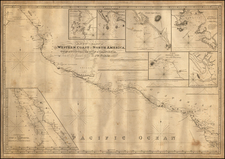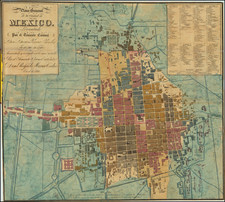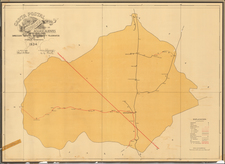Fascinating drawing of a surveyed town with parish church and hospital
This is an astonishing illustration of a survey of a town made as part of a lawsuit between residents and a group of mulatos, mixed-race peoples, living across a river. It is wonderfully detailed and also reveals the method by which surveys were taken in colonial New Spain.
The town has both a parish church and a hospital, indicating it was of some importance in the area. It also has many trees and fields under cultivation-it is a thriving religious community dependent on agriculture. Between the church and the hills is a river labeled both with the word r ío and a row of waves. A larger river flows from the hills and out the right side of the drawing. A road runs in front of the pueblo, as well as one leading to the hospital and to a cross that acts as a monument.
The cross is of particular importance, as a note near it explains that it served as the " centro de las medidas del Pueblo". This means that this was the spot from where the survey radiated. The measurements were taken from the center to landmarks, marked here as moxoneras.
On the hills to the north of the property, at the top of the drawing, a note describes these as the laderas del Litizio, or the slopes under litigation. As the note explains, the land dispute is between the town and the mulatos, or people of mixed Spanish and indigenous descent. It seems the quarrel required a survey be taken to show rival claims. Such suits were the main reason for surveys to be made in colonial New Spain.
Unfortunately, the detail of the drawing as to surveying and the economic and religious life of the pueblo is not matched by the details of the town's name and location. However, it is still quite a comprehensive document and pleasantly drawn.











![[Yucatan Postal Map] Carta Postal de la Republica Mexicana Estado de Yucatan . . . 1934](https://storage.googleapis.com/raremaps/img/small/55195.jpg)

![(Mexican-Aztec Painting) [Watercolor of three Aztec deities from the Codex Vaticanus:] Toxcatl, God of Droughts and Inundations. Cod. Vat. Tlaloc. God of Water. Cod. Vat. Tecuilvitontl [Tecuilhuitontli] The Lesser Festival of the Lords. Cod. Vat.](https://storage.googleapis.com/raremaps/img/small/103009.jpg)
